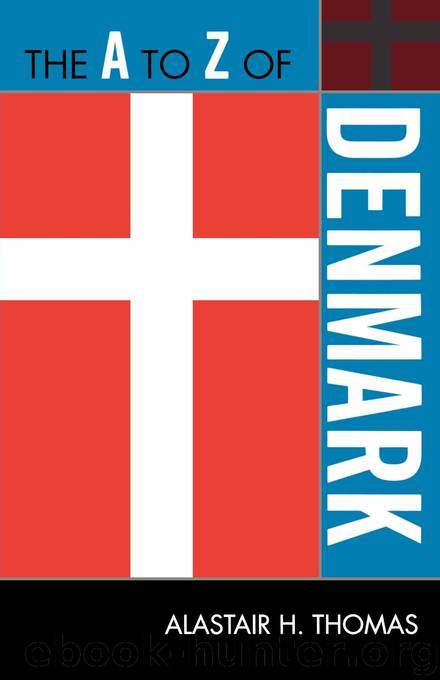The A to Z of Denmark by Alastair H. Thomas

Author:Alastair H. Thomas
Language: eng
Format: epub
Publisher: Scarecrow Press
Published: 2009-03-14T16:00:00+00:00
KAAS, NIELS (1534-1594). Politician. Of a noble family, he studied history and public law abroad. He became a secretary in the chancellery and in 1570-94 was a member of the Council of State, acting as royal Chancellor from 1570. He advocated a policy of caution toward Sweden and supporting scientists such as A.S. Vedel and Tycho Brahe. After Frederik II died in 1588, Kaas headed the council of state during Christian IV’s minority. He died at Viborg and was buried in the cathedral.
KAAS, PREBEN (1930-1981). Actor. He won a large public following for his crazy and satirical revue numbers. In 1960-66 he appeared at the ABC Theater in Copenhagen, and in 1969-77 was director of the Circus Revue.
KALMAR UNION, named for the castle and port in southeast Sweden, was a political union between the kingdoms of Denmark, Norway, and Sweden. At its height it was the largest kingdom in Europe. Formed in 1397 and finally dissolved in 1521, its origins lie in the union of the Danish and Norwegian crowns under the young Oluf III (1370-1387) in 1380. After Albrecht of Mecklenburg was deposed from the Swedish throne in 1386, the Swedish nobles negotiated with Oluf’s mother Margrethe with a view to offering her son the throne of Sweden. When Oluf died suddenly they offered her the position of regent. The close ties between the leading families of the three kingdoms and the common threat of German economic domination made the idea of a union widely popular, and in 1397 Margrethe’s nephew Erik of Pomerania was crowned King of Denmark, Norway, and Sweden in Kalmar, the terms of the union being defined in a Coronation Letter and a Union Letter, although these offered differing interpretations of royal power.
From early in the history of the Kalmar Union, the Swedish nobility proved sensitive about their rights, which they often considered infringed by a ruler who resided most of the time in Copenhagen. They revolted against King Erik in 1438 and chose their own king, but the Union was restored with the election in 1440-42 of Christoffer of Bavaria as king in all three countries, only to be broken when, on his death in 1448, the Swedes chose a different successor to the throne. King Hans was again king of all three countries in 1501-3, as was King Christian II in 1520-21. The Swedish revolt led by Gustav Vasa in 1521 proved to be the end of the Union, although Dano-Norwegian kings did not finally abandon hope of its revival until after the Great Northern War. In the mid-19th century it was the inspiration of Scandinavianism. SPO
KALMAR WAR (1611-1613). This war began with a Danish attack on the Swedish port of Kalmar. Disputes had arisen between the two countries over the Sound tolls and mutual claims in Arctic Scandinavia, but the young King Christian IV also dreamed of reviving the Kalmar Union. The Danes had the better of the fighting, but their armies could not reach Stockholm by land, and an attempt by sea was repelled.
Download
This site does not store any files on its server. We only index and link to content provided by other sites. Please contact the content providers to delete copyright contents if any and email us, we'll remove relevant links or contents immediately.
| Africa | Americas |
| Arctic & Antarctica | Asia |
| Australia & Oceania | Europe |
| Middle East | Russia |
| United States | World |
| Ancient Civilizations | Military |
| Historical Study & Educational Resources |
Room 212 by Kate Stewart(4741)
The Crown by Robert Lacey(4574)
Endurance: Shackleton's Incredible Voyage by Alfred Lansing(4508)
The Iron Duke by The Iron Duke(4124)
The Rape of Nanking by Iris Chang(4024)
Killing England by Bill O'Reilly(3899)
Joan of Arc by Mary Gordon(3786)
Say Nothing by Patrick Radden Keefe(3726)
I'll Give You the Sun by Jandy Nelson(3274)
Shadow of Night by Deborah Harkness(3177)
Hitler's Monsters by Eric Kurlander(3165)
Mary, Queen of Scots, and the Murder of Lord Darnley by Alison Weir(3069)
Blood and Sand by Alex Von Tunzelmann(3060)
Darkest Hour by Anthony McCarten(3019)
Margaret Thatcher: The Autobiography by Thatcher Margaret(2972)
Eleanor & Park by Rainbow Rowell(2944)
Red Famine: Stalin's War on Ukraine by Anne Applebaum(2816)
Book of Life by Deborah Harkness(2721)
The One Memory of Flora Banks by Emily Barr(2686)
